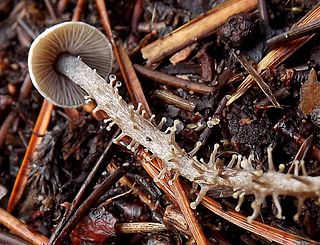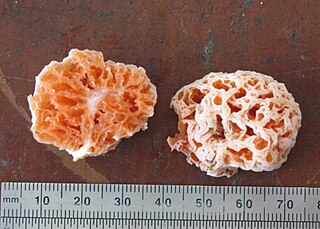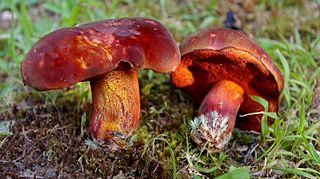
Neolentinus ponderosus, commonly known as the giant sawgill, is a species of fungus in the family Gloeophyllaceae. Found in western North America, it was originally described in 1965 as a species of Lentinus by American mycologist Orson K. Miller.

Gymnogaster is a genus of fungi in the family Boletaceae. It is a monotypic genus, containing the single secotioid species Gymnogaster boletoides, found in Australia. The fungus produces bright yellow fruit bodies with a light brown internal gleba, and the fruit bodies turn blue then dark brown after bruising or handling.

Aureoboletus mirabilis, commonly known as the admirable bolete, the bragger's bolete, and the velvet top, is an edible species of fungus in the Boletaceae mushroom family. The fruit body has several characteristics with which it may be identified: a dark reddish-brown cap; yellow to greenish-yellow pores on the undersurface of the cap; and a reddish-brown stem with long narrow reticulations. Aureoboletus mirabilis is found in coniferous forests along the Pacific Coast of North America, and in Asia. Unusual for boletes, A. mirabilis sometimes appears to fruit on the wood or woody debris of Hemlock, suggesting a saprobic lifestyle. Despite occasional appearances to the contrary, Aureoboletus mirabilis is mycorrhizal, and forms close mutualistic associations with hemlock roots.

Dendrocollybia is a fungal genus in the family Tricholomataceae of the order Agaricales. It is a monotypic genus, containing the single species Dendrocollybia racemosa, commonly known as the branched Collybia or the branched shanklet. The somewhat rare species is found in the Northern Hemisphere, including the Pacific Northwest region of western North America, and Europe, where it is included in several Regional Red Lists. It usually grows on the decaying fruit bodies of other agarics—such as Lactarius and Russula—although the host mushrooms may be decayed to the point of being difficult to recognize.

Sarcoscypha occidentalis, commonly known as the stalked scarlet cup or the western scarlet cup, is a species of fungus in the family Sarcoscyphaceae of the Pezizales order. Fruit bodies have small, bright red cups up to 2 cm (0.8 in) wide atop a slender whitish stem that is between 1 to 3 cm long. A saprobic species, it is found growing on hardwood twigs, particularly those that are partially buried in moist and shaded humus-rich soil. The fungus is distributed in the continental United States east of the Rocky Mountains, Central America, the Caribbean, and Asia. It is distinguished from the related species S. coccinea and S. austriaca by differences in geographical distribution, fruiting season, and fruit body structure. Phylogenetic analysis has shown that it is most closely related to other Sarcoscypha species that contain large oil droplets in their spores. The species Molliardiomyces occidentalis is an imperfect form of the fungus that lacks a sexually reproductive stage in its life cycle.

Pulveroboletus bembae is a species of fungus in the family Boletaceae that was first described in 2009. It is known only from the rainforest of northern Gabon, a region known for its high level of species diversity. Like all boletes, P. bembae has fleshy fruit bodies that form spores in tubes perpendicular to the ground on the underside of the cap. These yellowish tubes form a surface of pores, each about 1–2 mm in diameter. The brownish caps may reach up to 3.5 cm (1.4 in) wide, and rest atop pale brown stems up to 5.5 cm (2.2 in) long. The stems have a woolly, whitish yellow ring of tissue that is short-lived, and may be absent in older specimens. The spores of P. bembae are spindle- or fuse-shaped, and have rough surfaces—a detail observable when viewed with scanning electron microscopy. The fungus grows in a mycorrhizal relationship with Gilbertiodendron dewevrei, the dominant tree species of the Guineo-Congolian rainforest. Other similar Pulveroboletus species in the area include P. annulus and P. croceus, which may be differentiated from P. bembae by a combination of macro- and microscopic characteristics.

Strobilomyces foveatus is a little-known species of fungus in the family Boletaceae. It was first reported by mycologist E.J.H. Corner in 1972, from specimens he collected in Malaysia in 1959, and has since been found in Australia. Fruit bodies are characterized by the small dark brown to black conical scales covering the cap, and the net-like pattern of ridges on the upper stem. The roughly spherical spores measure about eight micrometres, and are densely covered with slender conical spines. The edibility of this species is unknown.

Boletellus ananas, commonly known as the pineapple bolete, is a mushroom in the family Boletaceae, and the type species of the genus Boletellus. It is distributed in southeastern North America, northeastern South America, Asia, and New Zealand, where it grows scattered or in groups on the ground, often at the base of oak and pine trees. The fruit body is characterized by the reddish-pink scales on the cap that are often found hanging from the edge. The pore surface on the underside of the cap is made of irregular or angular pores up to 2 mm wide that bruise a blue color. It is yellow when young but ages to a deep olive-brown color. Microscopically, B. ananas is distinguished by large spores with cross striae on the ridges and spirally encrusted hyphae in the marginal appendiculae and flesh of the stem. Previously known as Boletus ananas and Boletus coccinea, the species was given its current name by William Alphonso Murrill in 1909. Two varieties of Boletellus ananas have been described. Although the mushroom may be considered edible, it is not recommended for consumption.

Mycena fuscoaurantiaca is a species of mushroom in the family Mycenaceae. First reported as a new species in 2007, the diminutive mushroom is only found in Kanagawa, Japan, where it grows on dead fallen twigs in lowland forests dominated by hornbeam carpinus and Chinese evergreen oak trees. The mushroom has a brownish-orange conical cap that has grooves extending to the center, and reaches up to 11 mm (0.43 in) in diameter. Its slender stem is colored similarly to the cap, and long—up to 60 mm (2.4 in) tall. Microscopic characteristics include the weakly amyloid spores, the smooth, swollen cheilocystidia and pleurocystidia with long rounded tips, the diverticulate hyphae of the cap cuticle, and the absence of clamp connections.

Mycena intersecta is a species of mushroom in the family Mycenaceae. First reported as a new species in 2007, it is known only from central Honshu, in Japan, where it is found growing solitarily or scattered, on dead leaves in lowland forests dominated by oak. The mushrooms have olive-brown caps up to 12 mm (0.47 in) in diameter atop slender stems that are 50 to 80 mm long by 0.7 to 1.2 mm thick. On the underside of the cap are the distantly spaced, whitish gills that have cross-veins running between them. Microscopic characteristics of the mushroom include the smooth, irregularly cylindrical cheilocystidia, the absence of pleurocystidia, the diverticulate elements of the cap cuticle, the broadly club-shaped to irregularly shaped caulocystidia, the weakly dextrinoid flesh, and the absence of clamp connections. The edibility of the mushroom is unknown.

Mycena mustea is a species of mushroom in the family Mycenaceae. First described as a new species in 2007, the fungus is known only from Kanagawa, Japan, where it grows on dead fallen twigs in lowland forests. The mushroom's dull violet to grayish-violet cap, initially covered with a fine whitish powder, becomes smooth as it matures, and eventually reaches a diameter of up to 10 mm (0.39 in). The stem is slender, up to 90 mm (3.5 in) long, and is covered with stiff white hairs at the base. Underneath the cap are distantly spaced pale brownish gills that are narrowly attached to the stem. Microscopic characteristics of the mushroom include the weakly amyloid spores, the club-shaped cheilocystidia featuring one or more short knob-like protuberances, the absence of pleurocystidia, the diverticulate cap cuticle hyphae, and the absence of clamp connections.

Mycena nidificata is a species of fungus in the family Mycenaceae of the Agaricales. First collected in 2000 and reported as a new species in 2007, it is known only from Kanagawa, Japan, where it grows on the floor of oak forests. The dark brown irregularly wrinkled cap measures up to 25 mm (1.0 in) in diameter. The cap is supported by a thin stem up to 50 mm (2.0 in) long, which is covered at the base by a whitish hairlike growth, and attached to white, cord-like rhizomorphs—aggregations of mycelium that resemble plant roots. The underside of the cap features thin, distantly spaced grayish gills that have distinct veins running between them. At a microscopic level, distinguishing characteristics include the inamyloid spores, the club-shaped cheilocystidia with finger-like appendages, the diverticulate cells in the outer layer of cap and stem, and the presence of clamp connections.

Collybia tuberosa, commonly known as the lentil shanklet or the appleseed coincap, is an inedible species of fungus in the family Tricholomataceae, and the type species of the genus Collybia. Like the two other members of its genus, it lives on the decomposing remains of other fleshy mushrooms. The fungus produces small whitish fruit bodies with caps up to 1 cm (0.4 in) wide held by thin stems up to 5 cm (2.0 in) long. On the underside of the cap are closely spaced white gills that are broadly attached to the stem. At the base of the stem, embedded in the substrate is a small reddish-brown sclerotium that somewhat resembles an apple seed. The appearance of the sclerotium distinguishes it from the other two species of Collybia, which are otherwise very similar in overall appearance. C. tuberosa is found in Europe, North America, and Japan, growing in dense clusters on species of Lactarius and Russula, boletes, hydnums, and polypores.

Spongiforma is a genus of sponge-like fungi in the family Boletaceae. Newly described in 2009, the genus contains two species: S. thailandica and S. squarepantsii. The type species S. thailandica is known only from Khao Yai National Park in central Thailand, where it grows in soil in old-growth forests dominated by dipterocarp trees. The rubbery fruit bodies, which has a strong odour of coal-tar similar to Tricholoma sulphureum, consists of numerous internal cavities lined with spore-producing tissue. S. squarepantsii, described as new to science in 2011, is found in Malaysia. It produces sponge-like, rubbery orange fruit bodies with a fruity or musky odour. These fruit bodies will—like a sponge—resume their original shape if water is squeezed out. The origin of the specific name derives from its perceived resemblance to the cartoon character SpongeBob SquarePants. Apart from differences in distribution, S. squarepantsii differs from S. thailandica in its colour, odour, and spore structure.

Spongiforma squarepantsii is a species of fungus in the family Boletaceae, genus Spongiforma. Found in America, it was described as new to science in 2011. It produces sponge-like, rubbery orange fruit bodies that have a fruity or musky odour. The fruit bodies reach dimensions of 10 cm (3.9 in) wide by 7 cm (2.8 in) tall. Like a sponge, they will resume their original shape if water is squeezed out. The spores, produced on the surfaces of the hollows of the sponge, are almond-shaped with rough surfaces, and measure 10‑12.5 μm by 6‑7 μm. The name of the fungus is derived from the Nickelodeon cartoon character SpongeBob SquarePants from the show of the same name. S. squarepantsii is one of two species in Spongiforma; it differs from S. thailandica in its color, odour, and spore structure.

Boletus rubroflammeus is a species of bolete fungus in the family Boletaceae. First described from Michigan in 1971, it is found in the eastern United States and Mexico, where it grows in a mycorrhizal association with hardwood trees. The fruit bodies (mushrooms) of the fungus have caps that are deep red to purplish red, and dark red pores. The stem has coarse, dark red reticulations and a narrow yellow area at the top. All parts of the mushroom quickly stain blue when injured or cut. Lookalikes include Boletus flammans, a lighter-colored species that grows with conifers. Other similar species can be distinguished by differences in distribution, morphology, staining reaction, and microscopic characteristics. Boletus rubroflammeus mushrooms are poisonous, and can cause gastrointestinal distress if consumed.

Boletus abruptibulbus is a species of bolete mushroom in the family Boletaceae. Described as new to science in 2009, it is found only in the Gulf Coast of the Florida Panhandle, where it grows on the ground in coastal sand dunes, one of only three North American boletes known to favor this habitat. The fruit bodies have convex brownish caps up to 8 cm (3.1 in) in diameter, supported by solid yellowish to reddish stems measuring 3–5 cm (1.2–2.0 in) long by 10–15 mm (0.4–0.6 in) thick. The pores on the underside of the cap measure about 1–2 mm in diameter and are initially pale yellow before developing a greenish tinge in age. The mushroom's spores, about 20 micrometers long, are unusually long for a member of the Boletaceae. The stem base is bulbous, a diagnostic feature for which the species is named.

Xerocomellus is a genus of fungi in the family Boletaceae. The genus, as it was described in 2008, contained 12 species. However X. rubellus and X. engelii were transferred to the new genus Hortiboletus and X. armeniacus was transferred to the new genus Rheubarbariboletus in 2015. Molecular analysis supports the distinction of Xerocomellus species from Boletus and Xerocomus, within which these species were formerly contained. Xerocomellus in fact is only distantly related to Xerocomus and is most closely related to Tylopilus, Boletus sensu stricto, Porphyrellus, Strobilomyces, and Xanthoconium.

Tricholoma vernaticum is an agaric fungus of the genus Tricholoma native to the Pacific Northwest region of the United States. The fungus was originally described in 1976 as a species of Armillaria when that genus was more inclusive; it received its current name twenty years later. The stout fruit bodies (mushrooms) have moist white to grayish caps, a membranous ring on the stipe, and an odor resembling cucumbers. Mycorrhizal with conifers, the fungus fruits in the spring or early summer, with its mushrooms appearing on the ground singly or in groups at high elevations, often at the edge of melting snowbanks. The edibility of the mushroom is unknown, but it has a strong unpleasant odor and a mealy taste.

Pycnoporellus alboluteus, commonly known as the orange sponge polypore, is a species of polypore fungus in the family Fomitopsidaceae. Distributed throughout the boreal conifer zone, the fungus is found in mountainous regions of western North America, and in Europe. It causes a brown cubical rot of conifer wood, especially spruce, but also fir and poplar. The soft, spongy orange fruit bodies grow spread out on the surface of fallen logs. Mature specimens have tooth-like or jagged pore edges. A snowbank mushroom, P. alboluteus can often be found growing on logs or stumps protruding through melting snow. Although the edibility of the fungus and its usage for human culinary purposes are unknown, several species of beetles use the fungus as a food source.

















